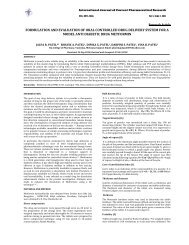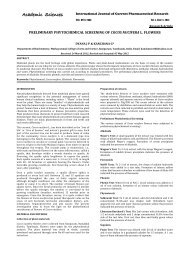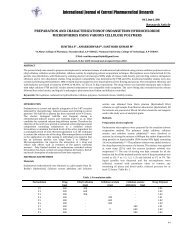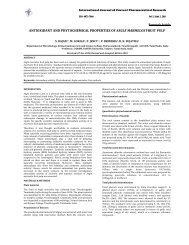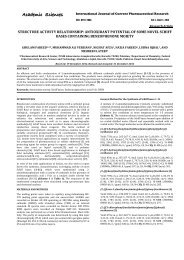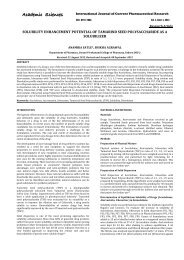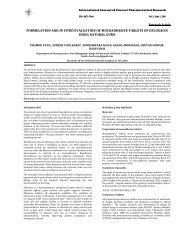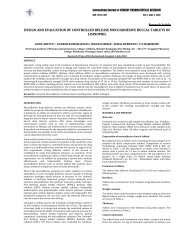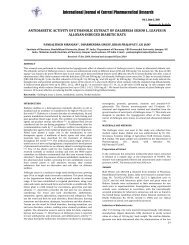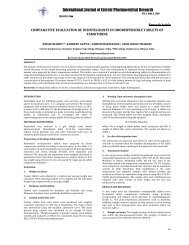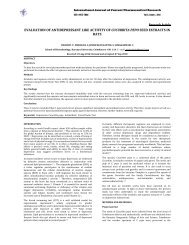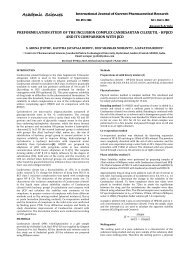preliminary phytochemical screening of medicinal plant ziziphus ...
preliminary phytochemical screening of medicinal plant ziziphus ...
preliminary phytochemical screening of medicinal plant ziziphus ...
- No tags were found...
You also want an ePaper? Increase the reach of your titles
YUMPU automatically turns print PDFs into web optimized ePapers that Google loves.
Academic SciencesInternational Journal <strong>of</strong> Current Pharmaceutical ResearchISSN- 0975-7066 Vol 4, Issue 3, 2012Research ArticlePRELIMINARY PHYTOCHEMICAL SCREENING OF MEDICINAL PLANT ZIZIPHUS MAURITIANALAM. FRUITSSURENDRA K. RATHORE*, SHASHANK BHATT, DR. SURESH DHYANI, AANCHAL JAINDepartment <strong>of</strong> Biotechnology, Rajiv Gandhi Govt. P.G. College, Mandsaur, Madhya Pradesh, India. 458001, NIMS University, Jaipur,Rajasthan, Rajiv Gandhi Govt. P.G. College, Mandsaur, Madhya Pradesh, India 458001. Email: Shashank_bhatt2003@yahoo.co.inABSTRACTReceived: 12 June 2012, Revised and Accepted: 29 June 2012The present paper shows the medical importance <strong>of</strong> Ziziphus mauritiana Lam. The <strong>plant</strong> fruit compounds were extracted with petroleum ether,chlor<strong>of</strong>orm, methanol, 95% ethanol and distilled water for 48 hours help <strong>of</strong> cold percolation method and found different types <strong>of</strong> secondarymetabolites as flavonoids, glycosides, saponins, phenols, lignins, sterols and tannins were presented.Keywords: Flavonoids, Glycosides, Saponins, Tannins, Ziziphus Mauritiana Lam.INTRODUCTIONPlants are part <strong>of</strong> life. Without them nobody can live. Mostlypeople believe in ayurvedic or unani medicines because they donot show any side effects compared to allopathic medicines. Whena <strong>plant</strong> has an antibiotic properties it is called <strong>medicinal</strong> <strong>plant</strong>s.About 80% <strong>of</strong> the world population use traditional medicines,which are predominantly based on <strong>plant</strong> materials [WHO; 1993].These materials are primarily and secondarily metabolites.In India, different regions have specific features according to theclimatic conditions. These <strong>plant</strong>s including <strong>medicinal</strong> <strong>plant</strong>s arealso used as a feeding for animals. They are indirectly shown bytheir effects by which animals do not suffer by any types <strong>of</strong>diseases. Growing <strong>plant</strong>s are one <strong>of</strong> the cheapest sources <strong>of</strong>feeding for animals having crude proteins <strong>of</strong> 14-25% [Abdu SB. et.al 2007, Simbaya J; 2002]. These <strong>plant</strong>s provide vitamins andminerals which are lacking in grassland pastures [Keay RWJ;1989].Ziziphus is one <strong>of</strong> which that is found in all over the world. Differenttypes <strong>of</strong> morphological changes are found cause to temperature andclimate changes. According to their morphological change, thespecies names were decided. Ziziphus mauritiana Lam. is one <strong>of</strong>which that is grown in dry places. It is generally used for feeding bycattle and camels and goats and get resistance power againstdifferent types <strong>of</strong> pathogens [Morton J., 1987]. Ziziphus mauritianaLam. belongs to the family <strong>of</strong> Ziziphus belongs to the kingdom;<strong>plant</strong>ae, order; roasles, division; magnoliophyta, class;magnoliopsida, family; rhamnaceae, genus; Ziziphus, species;mauritiana.Ziziphus mauritiana Lam. is also called jujube tree [Morton; 1987,Michel 2002]. All the parts <strong>of</strong> this <strong>plant</strong> are very effective against thedifferent types <strong>of</strong> diseases. Its leaves are useful in the treatment <strong>of</strong>diarrhea, wounds, abscesses, swelling and gonorrhoea [Michel;2002]. The leaves mauritiana are also used in the treatment <strong>of</strong> liverdiseases, asthma and fever [Morton; 1987]. Carbohydrates, starch,proteins, sugar, mucilages and vitamins are abundantly found in<strong>ziziphus</strong> species [Clifford S.C. Paper- Characterization; 2002].Ziziphus mauritiana Lam. fruits can be used in the treatment <strong>of</strong> liver[Dahiru, D. et.al. 2005].Ziziphus mauritiana Lam. fruiting time is February to March endingand the colour is red with more juicy as like litchi. The fruit has beenused as anodyne, sedative, tonic anticancer, potent wound healer. Ithas also been used against asthma [J. Morton; 1987, E. W. M. Verheijand M. Calabura; 1991]. The fruit [A. R. Ndhala; 2006] leaves [D.Dahiru and O. Obidoa; 2007] and seeds [A. Bhatia and T. Mishra;2009] extracts have been exhibit antioxidant activity whereas bark[E. Pisha et. al. 1995] is reported to cytotoxicity against differentcancer cell lines.MATERIAL AND METHODSCollection <strong>of</strong> Plant MaterialZiziphus mauritiana Lam. is found all over the world. I had collectedthe <strong>plant</strong> ripped fruits from Mandsaur district, Madhya Pradesh.Mandsaur District forms the northern projection <strong>of</strong> Madhya Pradesh.It lies between the parallels <strong>of</strong> latitude 23 0 45' 50" North and 25 0 2'55" North, and between the meridians <strong>of</strong> longitude 74 0 42' 30" Eastand 75 0 50' 20" East.Preliminary Screening <strong>of</strong> Secondary MetabolitesThe ripped fruits were dried and powdered using mixer grinder, andsubjected to cold percolation process for 48 hours with petroleumether, chlor<strong>of</strong>orm, 95% ethanol, methanol and distilled water. Afterthis process, the extracts were filtered and used for <strong>preliminary</strong><strong>phytochemical</strong> <strong>screening</strong> such as alkaloids (Iodine, Wagner, andDragendorff’s test), flavonoids (Pew’s, Shinoda and NaOH tests),glycosides(Keller-killani, Conc. H 2SO 4, and Molisch tests), saponins(Foam and Haemolysis test), sterols (Libermann- Burchard, andSalkowski tests), tannins (Gelatin and Lead acetate test), Lignin(Labat and Lignin tests), Phenols (Ellagic acid and Phenol tests)were carried out [Shashank Bhatt et. al.,2011].Preliminary Screening <strong>of</strong> Phytochemical TestPhytochemical ScreeningThe filtrate obtained was subjected to Preliminary Phytochemical<strong>screening</strong>.Test for AlkaloidsIodine Test: Mix 3 ml test solution and added few drops <strong>of</strong> diluteiodine solution. Blue colour appears; it disappears on boiling andreappears on cooling [Khandewal K.R., 2008].Wagner’s Test: To 2-3 ml extract with few drops Wagner’s reagent.Formation <strong>of</strong> reddish brown precipitate indicates the presence <strong>of</strong>alkaloids [Kokate C. K. et. al; 2001].Dragendorff’s Tests: To 2-3 ml extract, add few dropsDragendorff’s reagent Formation <strong>of</strong> orange brown precipitateindicates the presence <strong>of</strong> alkaloids [Kokate C. K. et. al; 2001].Test for FlavonoidsPew’s Tests: To 2-3 ml extract, added zinc powder in a test tube,followed by dropwise addition <strong>of</strong> conc. HCl. Formation <strong>of</strong> purple redor cherry colour indicates the presence <strong>of</strong> flavonoids [Peach K.,Tracey MV. 1956].Shinoda Tests: To 2-3 ml extract, few fragments <strong>of</strong> magnesiummetal were added in a test tube, followed by dropwise addition <strong>of</strong>
Rathore et al.Int J Curr Pharm Res, Vol 4, Issue 3, 160-162concentrate HCl. Formation <strong>of</strong> magenta colour indicated thepresence <strong>of</strong> flavonoids [Kokate C. K. et. al; 2001].NaOH Tests: To 2-3 ml <strong>of</strong> extract, few drops <strong>of</strong> sodium hydroxidesolution were added in a test tube. Formation <strong>of</strong> intense yellowcolour that became colourless on addition <strong>of</strong> few drops <strong>of</strong> dilute HClindicated the presence <strong>of</strong> flavonoids [Khandewal K.R., 2008].Test for GlycosidesKeller-Kiliani Test: To 2 ml extract, add glacial acetic acid, one drop5% FeCl3 and conc. H2SO4. Reddish brown color appears at junction<strong>of</strong> the two liquid layers and upper layer appears bluish greenindicates the presence <strong>of</strong> glycosides [Kokate C. K. et.al; 2001].Glycosides test: To small amount <strong>of</strong> extract, add 1 ml water andshake well. Then aqueous solution <strong>of</strong> NaOH was added. Yellowcolour appeared that indicates the presence <strong>of</strong> glycosides. [TreareGE, Evans WC. 1985].Concentrate H 2SO 4 Test: To 5ml extract, add 2ml glacial aceticacid, one drop 5% FeCl 3 and conc. H2SO 4.The appearance <strong>of</strong> brownring indicates the presence <strong>of</strong> glycosides [Khandewal K.R., 2008].Molisch’s Test: To 1 ml <strong>of</strong> extract, 2 drops <strong>of</strong> Molisch’s regent wasadded in a test tube and 2 ml <strong>of</strong> concentrate H2SO4 was addedcarefully keeping the test tube slightly curved. Formation <strong>of</strong> violetring at the junction indicated the presence <strong>of</strong> glycosides [Kokate C. K.et. al; 2001].Test for PhenolsEllagic Acid Test: The test solution was treated with few drops <strong>of</strong>5% (w/v) glacial acetic acid and 5% (w/v) NaNO 2solution. Thesolution turned muddy or niger brown precipitate occurred in theextract indicated the presence <strong>of</strong> phenols solution [Gibbs R.D., 1974].Phenol Tests: To 0.5 ml <strong>of</strong> FeCl 3 (w/v) solution was added to 2 ml<strong>of</strong> test solution, formation <strong>of</strong> an intense colour indicated thepresence <strong>of</strong> phenols [Gibbs R.D., 1974].Test for LigninsLignin test: To 2 ml <strong>of</strong> 2% (w/v) furfuraldehyde was added to thetest solution, formation <strong>of</strong> red colour indicated the presence <strong>of</strong> lignin[Gibbs R.D., 1974].Labat test: The test solution was mixed with gallic acid; it developedolive green colour indicating the positive reaction for lignins [GibbsR.D., 1974].Test for saponinsFoam Test: The extract was diluted with 20 ml <strong>of</strong> distilled waterand it was shaken in a graduated cylinder for 15 minutes. A 1 cm.layer <strong>of</strong> foam indicated the presence <strong>of</strong> saponins [Kokate C. K. et. al;2001].Haemolysis Tests: - Add leaves extract to one drop <strong>of</strong> blood placedon glass slide. Hemolytic zone appears [Kokate C.K., 1994].Test for SterolsLiebermann-Burchard Test: Mix 2ml extract with chlor<strong>of</strong>orm. Add1-2 ml acetic anhydride and 2 drops concentrated H2SO 4 from theside <strong>of</strong> the test tube. First red, then blue and finally green colourindicated the presence <strong>of</strong> sterols [Kokate C. K. et. al; 2001].Salkowski’s Test: To 2 ml <strong>of</strong> extract, add 2ml chlor<strong>of</strong>orm and 2 mlconcentrated H2SO4and was shaken well. Chlor<strong>of</strong>orm layerappeared red and acid layer showed greenish yellow fluorescenceindicated the presence <strong>of</strong> sterols [Kokate C. K. et. al; 2001].Test for TanninsGelatin Test: To the extract, gelatin (gelatin dissolves in warm waterimmediately) solution was added. Formation <strong>of</strong> white precipitateindicated the presence <strong>of</strong> tannins [Treare GE, Evans WC. 1985].Lead acetate test: To 5 ml <strong>of</strong> extract, add few drops <strong>of</strong> 10% leadacetate solution were added. Formation <strong>of</strong> yellow or red precipitateindicated the presence <strong>of</strong> tannins. [Treare GE, Evans WC. 1985].RESULT AND DISCUSSIONThe <strong>plant</strong> ripped fruits were powdered and subjected to coldpercolation with petroleum ether, chlor<strong>of</strong>orm, methanol, 95%ethanol and distilled water for 48 hours. The results <strong>of</strong> the<strong>phytochemical</strong> <strong>screening</strong> <strong>of</strong> fruits extract <strong>of</strong> Ziziphus mauritianaLam. were presented in Table-1. Different types <strong>of</strong> secondarymetabolites such as flavonoids glycoside, phenol, lignin, saponins,sterols and tannins were present while alkaloids was absent inZiziphus mauritiana Lam. [Table-1]Table 1: Phytochemical study <strong>of</strong> <strong>ziziphus</strong> mauritiana lam. FruitsTest Petroleum Ether Chlor<strong>of</strong>orm Methanol 95% Ethanol Distilled waterAlkaloidsIodine Test -ve -ve -ve -ve -veWagner’s Test -ve -ve -ve -ve -veDragendorff Test -ve -ve -ve -ve -veFlavonoidsPews Test -ve -ve -ve -ve -veShinoda Test -ve -ve -ve -ve -veNaOH Test -ve -ve +ve +ve -veGlycosidesKeller-Killani Test -ve +ve +ve +ve -veGlycosides Test -ve -ve +ve +ve -veConc. H2SO4 -ve +ve +ve +ve -veMolisch’s Test -ve -ve -ve -ve -vePhenolEllagic Test -ve -ve -ve -ve -vePhenol Test -ve -ve -ve +ve +veLigninLignin Test -ve -ve +ve +ve -veLabat Test -ve -ve +ve +ve -veSaponinsFoam Test -ve -ve +ve +ve -veHaemolysis Test -ve -ve -ve +ve -veSterolsLibermann- Burchard Test -ve -ve -ve -ve -veSalkowski Test -ve +ve +ve +ve -veTanninsGelatin Test -ve -ve +ve -ve -ve161
Rathore et al.Int J Curr Pharm Res, Vol 4, Issue 3, 160-162Lead Acetate Test -ve -ve +ve +ve +veFig. A: The fruit <strong>of</strong> <strong>ziziphus</strong> mauritiana lam.Tannins have general antimicrobial and antioxidant activities[Rievere et. al., 2009]. Current reports show that tannins may havepotential value such as cytotoxic and antineoplastic agents[Aguinaldo et. al., 2005]. Saponins have antifungal properties[Aboada and Efuwape, 2001; Mohanta et. al., 2007]. These contentsare shown different type <strong>of</strong> activity against different pathogens.Therefore, it can be used in the treatment <strong>of</strong> diseases.Saponins are used in hypercholesterolemia, hyperglycemia,antioxidant, anticancer, anti-inflammatory and weight loss etc.according to medical field. It is a bioactive antibacterial agent <strong>of</strong><strong>plant</strong>s [Mandal et. al. 2005: Manjunatha, 2006].CONCLUSIONAccording to the research works on Ziziphus mauritiana Lam. fruit, Ihave concluded that different types <strong>of</strong> secondary metabolites arepresent that have effective functions on different type <strong>of</strong> diseases. Itshows very effective function against pathogens. Hence, its fruit canbe used in the treatment <strong>of</strong> liver diseases according to their functionand also used in cancer treatment. The fruits should be used in thepreparation <strong>of</strong> <strong>medicinal</strong> drug for the treatment <strong>of</strong> different types <strong>of</strong>cancer, antimicrobial and antifungal activity.ACKNOLEDGEMENTPraying and dedicating my research article to Maa Saraswati, thegoddess <strong>of</strong> knowledge & wisdom. I want to give thanks to mydepartment Head Dr. C.S. Gupta for permission to research work.The research work would have been a dream, had it not beenenlightened, by my well wishers and the above respectables. Lastbut not least the Almightly God is unforgettable without whosekindness and grace, nothing could have happened.REFERENCES1. Abdu SB, Ehoche OW, Adamu AM, Yashim SM, Jokthan GE.Evaluation <strong>of</strong> processing methods on biochemical composition<strong>of</strong> Ziziphus (Ziziphus mauritiana) leaf meal. Trop. J. Anim. Sci.2007; 10(1-2):441-3.2. Aboada, O.O., and B.M.Efuwape. 2001. Antibacterial properties<strong>of</strong> some Nigerian species. Biol. Res. Comm. 13: 183-188.3. Bhatia and T. Mishra, “Free radical scavenging and antioxidantpotential <strong>of</strong> Ziziphus mauritiana (Lamk.) seed extract,” Journal<strong>of</strong> Complementary and Integrative Medicine, vol. 8, pp. 42–46,2009.4. Aguinaldo, A.M., El-Espeso, B.Q.Guovara, M.G.Nanoto.2005.Phytochemistry. In: Guevara B.Q (ed) A.Guide book to <strong>plant</strong><strong>screening</strong> <strong>phytochemical</strong> and biological. University <strong>of</strong> SantoTomas, Manila, Philippines.5. R. Ndhala, C. H. Mupure, K. Chitindingue, M. A. N. Benhura, andM. Muchuweti, “Antioxidant potentials and degree <strong>of</strong>polymerization <strong>of</strong> six wild fruits,” Life ScienceResearch Assays,vol. 1, pp. 87–92, 2006.6. Clifford S.C., Arndt S.K., Popp M. and Jones H.G., Mucilages andpolysaccharides in Ziziphus species (Rhamnaceae): localization,composition and physiological roles during drought-stress,Journal <strong>of</strong> experimental Botany, 2002, 53 (366),131-138.7. Dahiru, D., William, E.T. and Nadro, M.S. Protective effect <strong>of</strong>Ziziphus mauritiana leaf extract on carbon tetrachlorideinducedliver injury. African journal <strong>of</strong> Biotechnology vol. 4(10), pp.1177-1179, 2005.8. D. Dahiru and O. Obidoa, “Pretreatment <strong>of</strong> albino rats withaqueous leaf extract <strong>of</strong> Zizyphus mauritiana protects againstalcohol induced liver damage,” Tropical Journal <strong>of</strong>Pharmaceutical Research, vol. 6, pp. 705–710, 2007.9. E. Pisha, H. Chai, I.-S. Lee et al., “Discovery <strong>of</strong> betulinic acid as aselective inhibitor <strong>of</strong> human melanoma that functions byinduction <strong>of</strong> apoptosis,” Nature Medicine, vol. 1, no. 10, pp.1046–1051, 1995.10. E. W. M. Verheij and M. Calabura, “Plant resources <strong>of</strong> South-East Asia 2,” in Edible Fruits and Nuts, E. W. M. Verheij and R. E.Coronel, Eds., pp. 223–225, PROSEA, Pudoc, Wageningen, TheNetherlands, 1991.11. Gibbs R.D., (1974) Chemotaxonomy <strong>of</strong> Flowering Plants. Vol.1,McGill Queen’s University Press, Montreal and London.12. J. Morton, “Indian jujube,” in Fruits <strong>of</strong> Warm Climates, J.F. Mortanand F. L. Miami, Eds., pp. 272–275, Center for New Crops & PlantProducts, Purdue University, Lafayette, Ind, USA, 1987.13. Keay RWJ. Trees <strong>of</strong> Nigeria.Clarendon Press, Oxford, NewYork.Pp 34-46. 1989.14. Khandewal K.R., (2008) Practical Pharmacognocy. NiraliPrakashan, Pune, edition: 19.15. Kokate C.K., (1994) Practical Pharmacognosy, 4th ed., VallabhPrakasan, Delhi, 107-111.16. Kokate C K, Purohit A P and Gokhale SB. (2001) Carbohydrate andderived Products, drugs containing glycosides, drugs containingtannins, lipids and protein alkaloids. Text book <strong>of</strong> Pharmacognosy,7, edition: 133 -166, 167- 254, 255-2 69, 272-310, 428-52 3.17. Mandal, P., S.P.Sinha Babu and N.C.Mandal. 2005. Antimicrobialactivity <strong>of</strong> Saponins from Acacia auriculiformis. Fitoterapia.,76(5): 462-565.18. Manjunatha, B.K. 2006. Antibacterial activity <strong>of</strong> Pterocarpussantalinus. Ind.J.Pharm.Sci., 68(1): 115-116.19. Michel A (2002). Tree, Shrub and Liana <strong>of</strong> West African Zones.Margraf Publishers GMBH, Paris. P. 440.20. Mohanta, T.K., J.K.Patra, S.K.Rath, D.K.Pal, H.N.Thatoi. 2007.Evaluation <strong>of</strong> antimicrobial activity and <strong>phytochemical</strong><strong>screening</strong> <strong>of</strong> oils and nuts <strong>of</strong> Semicarpus anacardium L.f. Sci.Res. Essay., 2(11): 486-490.21. Morton J. Indian Jujube. In Fruit <strong>of</strong> warm climates. F. Julia and J.Morton, eds. Miami, FL. Pp 272-5.1987.22. Peach K., Tracey MV. (1956) Modern methods <strong>of</strong> <strong>plant</strong> analysis.Vol. 3, Springer Verlag, Berlin.23. Rievere, C., J.H. Van Nguyen, L.Pieters, B.Dejaegher, Y.V.Heyden,C.V.Minh, J.Quetin-Leclercq. 2009. Polyphenols isolated fromantiradical extracts <strong>of</strong> Mallotus metcalfianus. Phytochemistry.,70: 86-94.24. Shashank bhatt, Dr. Suresh Dhyani. Preliminary <strong>phytochemical</strong><strong>screening</strong> <strong>of</strong> Ailanthus Excelsa Roxb. International Journal <strong>of</strong>Current pharmaceutical research. 2011; vol. 4, Issue 1, 87-89.25. Simbaya J. Potential <strong>of</strong> tree fodder / shrubs legumes as feedresources for dry season supplementation <strong>of</strong> small holderruminant animal. Report <strong>of</strong> National Institute for Scientific andIndustrial Research, Livestock and Pest Research Centre,Chilanga, Zambia. Pp 67-76. 2002.26. Treare GE, Evans WC. (1985) Pharmacognosy 17th edn., BahivTinal, London. P 149.27. WHO (1993). Regional Office for Western Pacific, researchguidelines for evaluating the safety and efficacy <strong>of</strong> herbalmedicines. Manila.162



